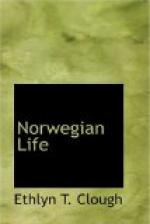There is a good deal of romance about saeter life in books, but I should say that there is very little in actual experience. Many of the charming fairy stories in Norwegian literature have their scenes in those mountain dairies. The saeter girls (saeterjenter they are called), have a peculiar and melodious cattle call, known as the Huldrelok, which is said to have been inherited from the Huldre-folk, a species of fairy that are very pretty, but unfortunately have tails. Usually a young farmer falls in love with one of the girls, and when he discovers that she has a tail, is so shocked and disappointed that he throws himself over a precipice; or perhaps the Huldre-folk gobble him up and carry him off into the mountains of the Josteldalsbrae and keep him there, while the girl he left behind him grieves herself to death because of his desertion.
The dairy maids are supposed to have a peculiar costume, and photographs are often seen of them arrayed in picturesque dress, but I never saw them worn. In all the saeters I visited the clothes worn were very plain and ordinary, and seemed to have been selected for wear and not for looks.
We visited a saeter one day and found two young people in charge, a boy and a girl, neither of them over seventeen, we should judge from appearances. Their herd consisted of fifteen cows, and they expected to remain in that desolate country two or three months, making cheese and butter. Our little saeterjenta had the heart of a poet, although her brother seemed stupid, and even liberal presents of money did not wake him up or make him interesting. I do not suppose that this child had ever been twenty miles from the humble cabin in which she was born, but the wide, wide world had been opened to her through the books she had studied at school. She could talk a little English, and knew a good deal about the United States. She had a brother in Minnesota, and many of the boys and girls in the neighborhood had gone across the Atlantic and found homes on the saeterless prairies of our Northwest. She would like to go herself, she said, but her mother was old and feeble and the work of the farm fell upon her little shoulders. Yet she was brave and contented. Her mind was clear, her imagination active, and among her homely surroundings she had found food for thought and an opportunity to give expression to the poetic sentiments that inspired her. Each of her fifteen cows had a name. One she called Moon Lady, because she often wanders away at night; another the Crown Wearer, because of a peculiar tuft upon her head. She addressed them all in terms of affection and talked to them, seeking their sympathy, for, poor child, they and that stupid, tow-headed broder were her only companions.
In the little saeterjenta we have a type of the laboring peasant women of Norway and Sweden; all willingly industrious and all philosophically extracting some sweets out of the burdensome life they must live, and that is why I say they deserve a tribute, whether in the field or factory, the saeter, the common home, or the palace.[s]




